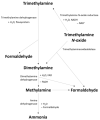Fresh Fish Degradation and Advances in Preservation Using Physical Emerging Technologies
- PMID: 33916441
- PMCID: PMC8066737
- DOI: 10.3390/foods10040780
Fresh Fish Degradation and Advances in Preservation Using Physical Emerging Technologies
Abstract
Fresh fish is a highly perishable food characterized by a short shelf-life, and for this reason, it must be properly handled and stored to slow down its deterioration and to ensure microbial safety and marketable shelf-life. Modern consumers seek fresh-like, minimally processed foods due to the raising concerns regarding the use of preservatives in foods, as is the case of fresh fish. Given this, emergent preservation techniques are being evaluated as a complement or even replacement of conventional preservation methodologies, to assure food safety and extend shelf-life without compromising food safety. This paper reviews the main mechanisms responsible for fish spoilage and the use of conventional physical methodologies to preserve fresh fish, encompassing the main effects of each methodology on microbiological and chemical quality aspects of this highly perishable food. In this sense, conventional storage procedures (refrigeration and freezing) are counterpointed with more recent cold-based storage methodologies, namely chilling and superchilling. In addition, the use of novel food packaging methodologies (edible films and coatings) is also presented and discussed, along with a new storage methodology, hyperbaric storage, that states storage pressure control to hurdle microbial development and slow down organoleptic decay at subzero, refrigeration, and room temperatures.
Keywords: chilling/refrigeration; edible coatings; freezing; fresh fish; hyperbaric storage; shelf-life; spoilage.
Conflict of interest statement
The authors have no conflict of interest to declare. There are no relevant financial or non-financial competing interests to report.
Figures



Similar articles
-
Chemical-Based Methodologies to Extend the Shelf Life of Fresh Fish-A Review.Foods. 2021 Sep 28;10(10):2300. doi: 10.3390/foods10102300. Foods. 2021. PMID: 34681354 Free PMC article. Review.
-
Spoilage and shelf-life extension of fresh fish and shellfish.Crit Rev Food Sci Nutr. 1996 Jan;36(1-2):87-121. doi: 10.1080/10408399609527720. Crit Rev Food Sci Nutr. 1996. PMID: 8747101 Review.
-
Analysis of Alternative Shelf Life-Extending Protocols and Their Effect on the Preservation of Seafood Products.Foods. 2022 Apr 12;11(8):1100. doi: 10.3390/foods11081100. Foods. 2022. PMID: 35454688 Free PMC article. Review.
-
Hyperbaric storage at room like temperatures as a possible alternative to refrigeration: evolution and recent advances.Crit Rev Food Sci Nutr. 2021;61(12):2078-2089. doi: 10.1080/10408398.2020.1770687. Epub 2020 Jun 4. Crit Rev Food Sci Nutr. 2021. PMID: 32496815 Review.
-
Principles and recent applications of novel non-thermal processing technologies for the fish industry-a review.Crit Rev Food Sci Nutr. 2019;59(5):728-742. doi: 10.1080/10408398.2018.1495613. Epub 2018 Dec 22. Crit Rev Food Sci Nutr. 2019. PMID: 30580554 Review.
Cited by
-
Toward Sustainable and Healthy Fish Products-The Role of Feeding and Preservation Techniques.Foods. 2023 Aug 8;12(16):2991. doi: 10.3390/foods12162991. Foods. 2023. PMID: 37627990 Free PMC article.
-
Surveillance of Antimicrobial Resistance in the Asian Seabass (Lates calcarifer) Supply Chain Using Nanopore Sequencing.Foods. 2025 May 10;14(10):1691. doi: 10.3390/foods14101691. Foods. 2025. PMID: 40428471 Free PMC article.
-
A Comprehensive Review on the Processing of Dried Fish and the Associated Chemical and Nutritional Changes.Foods. 2022 Sep 20;11(19):2938. doi: 10.3390/foods11192938. Foods. 2022. PMID: 36230013 Free PMC article. Review.
-
New Perspectives on Canned Fish Quality and Safety on the Road to Sustainability.Foods. 2025 Jan 2;14(1):99. doi: 10.3390/foods14010099. Foods. 2025. PMID: 39796393 Free PMC article. Review.
-
Assessment of the Effects of Salt and Salicornia herbacea L. on Physiochemical, Nutritional, and Quality Parameters for Extending the Shelf-Life of Semi-Dried Mullets (Chelon haematocheilus).Foods. 2022 Feb 18;11(4):597. doi: 10.3390/foods11040597. Foods. 2022. PMID: 35206073 Free PMC article.
References
-
- Ježek F., Buchtová H. Physical and Chemical Changes in Fresh Chilled Muscle Tissue of Common Carp (Cyprinus Carpio L.) Packed in a Modified Atmosphere. Acta Vet. Brno. 2007;76:S83–S92. doi: 10.2754/avb200776S8S083. - DOI
-
- Ghaly A., Dave D., Budge S., Brooks M. Fish Spoilage Mechanisms and Preservation Techniques: Review. Am. J. Appl. Sci. 2010;7:859–877. doi: 10.3844/ajassp.2010.859.877. - DOI
-
- Simopoulos A. Nutritional aspects of fish. In: Luten J., Börrensem T., Oehlenschläger J., editors. Producer to Consumer, Integrated Approach to Quality. Elsevier Science; London, UK: 1997. pp. 587–607.
-
- Simpson B.K., Nollet L.M.L., Toldrá F., Benjakul S., Paliyath G., Hui Y.H. Food Biochemistry and Food Processing. 2nd ed. Wiley-Blackwell; Hoboken, NJ, USA: 2012. pp. 13–288.
Publication types
Grants and funding
LinkOut - more resources
Full Text Sources
Other Literature Sources

